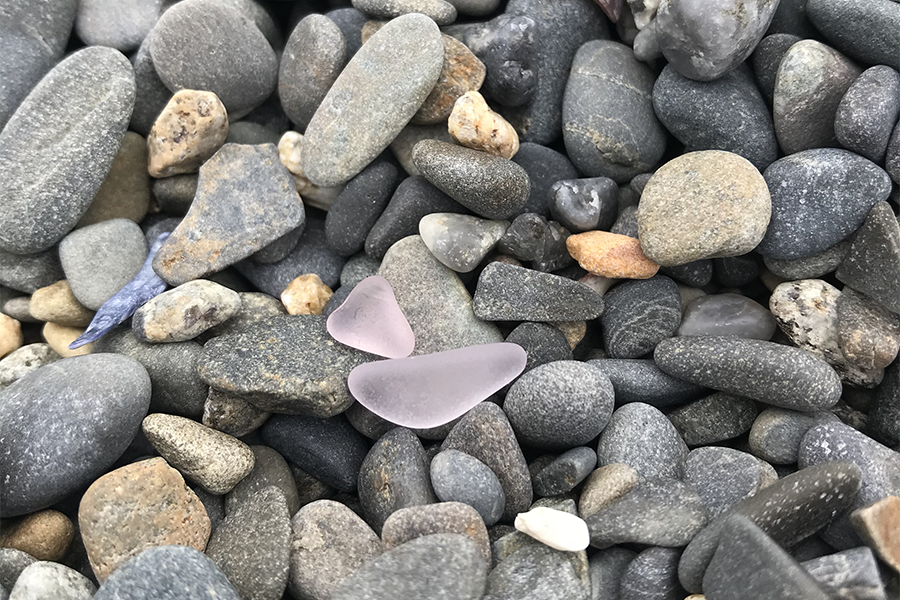Where to Hunt for Sea Glass around Massachusetts
For a new pandemic hobby, try hunting for ocean-weathered treasures along the shore.
by MAKENA GERA· 1/22/2021, 10:24 a.m.

Photo by Makena Gera
After decades of tumbling in the ocean, glass that was once trash becomes treasure after it’s worn down into cloudy and perfectly smooth fragments—also known as sea glass. Sometimes called “mermaid’s tears” or “sea gems,” a few pieces of brightly colored, well-worn glass can be found on nearly any stretch of rocky coastline, and makes for the perfect splash of color to brighten up your home. But the hunt will be even more successful if you’re looking in the right place.
Pebble-filled beaches located in an inlet or cove—where the tides dump everything from shells to stones and well-weathered shards of glass—nearly guarantee that you’ll leave with a collection of ocean treasure (after an hour or two of searching, of course). Finding these gems is a fun scavenger hunt for seasoned collectors and beachcombing newbies alike. So, if you’re looking for a new pandemic hobby that’s free and socially distant, or just an excuse to get outside, these spots around Massachusetts are the perfect places to start your search.
Pavilion Beach, Gloucester
The thrill of finding a perfectly worn, uniquely colored sea glass makes the hours of digging worth it. But it isn’t always easy to spot. If you’re new to sea glass hunting, Gloucester’s Pavilion Beach is a great starting point, because all you need to do is look down. The beach is covered in rocks—so much so that you might not go there on a regular beach day—which makes it a perfect home for sea glass. The most common pieces you’ll find are white and brown, but if you’re lucky, you’ll come across an elusive green, blue, or even red piece.
Commercial Street, Gloucester
Nantasket Beach, Hull
Located just about an hour south of Boston in Hull, Nantasket is one of the state’s busiest beaches in the summertime. Luckily, the best time of the year to look for sea glass is in the winter or early spring, after the rough waters of the season have washed new rocks and sea glass ashore—or churned up what’s already on the beach. Most of Nantasket’s mile-long shoreline is sandy, so stray towards the piles of pebbles and start your searching there instead. And don’t be afraid to dig. Some of the best pieces lay hidden beneath the layers of unassuming gray stones.
Nantasket Ave, Hull
Front and Back Beaches, Rockport
Like some of the best sea glass hunting spots, Rockport’s Front and Back Beaches are located inside a small inlet, where debris from the ocean washes in. While Front Beach isn’t too pebbly, you’re likely to find a few gems floating amongst the sand. Plus, if you want to make an afternoon out of it, you can check out some of the other beaches along the shore—probably after you do some shopping on Bearskin Neck. Just make sure you go at low tide, when more rocks and sea glass are revealed for you to sift through.
Beach Street, Rockport
Devereux Beach, Marblehead
With plenty of coarse sand and piles of rocks, Devereux Beach in Marblehead makes for an ideal spot to scavenge for sea glass. Take a stroll down the curve of the beach, where there are more rocks than sand—that’s where you’ll likely find an abundance of large and colorful pieces. Although the sea glass might be difficult to spot at first, the more you look, the easier it gets. Eventually, the characteristic cloudy surface and smooth edges of the pieces will start to stand out. You’ll become a pro at recognizing the distinct shine of a clear piece of glass when it’s slightly damp and the glint of a green shard nestled in the rocks.
Ocean Avenue, Marblehead
Long Beach, Plymouth
Long Beach is along Warren Cove in Plymouth, right at the end of a miles-long stretch of barrier beach that protects the city from the sea—meaning it catches everything the tides bring in. Look along the low and high tide lines, where the waves leave the most rocks and debris, or inside a pile of pebbles. Having the sun at your back also makes your scavenger hunt easier, as sunlight tends to glint off pieces of sea glass when they’re slightly wet. If you’re lucky, you might even find some horses taking a walk along the beach, too.
Ryder Way, Plymouth